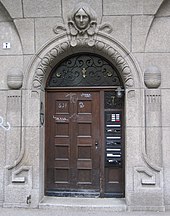| This article needs additional citations for verification. Please help improve this article by adding citations to reliable sources. Unsourced material may be challenged and removed. Find sources: "Artificial stone" – news · newspapers · books · scholar · JSTOR (February 2010) (Learn how and when to remove this message) |
You can help expand this article with text translated from the corresponding article in German. Click for important translation instructions.
|

Artificial stone is a name for various synthetic stone products produced from the 18th century onward. Uses include statuary, architectural details, fencing and rails, building construction, civil engineering work, and industrial applications such as grindstones.
History

One of the earliest examples of artificial stone was Coade stone (originally called Lithodipyra), a ceramic created by Eleanor Coade (1733–1821), and produced from 1769 to 1833. Later, in 1844, Frederick Ransome created a Patent Siliceous Stone, which comprised sand and powdered flint in an alkaline solution. By heating it in an enclosed high-temperature steam boiler the siliceous particles were bound together and could be moulded or worked into filtering slabs, vases, tombstones, decorative architectural work, emery wheels and grindstones.
This was followed by Victoria stone, which comprises three parts finely-crushed Mountsorrel (Leicestershire) granite to one of Portland cement, mechanically mixed and cast in moulds. When set the moulds are loosened and the blocks placed in a solution of sodium silicate for about two weeks to indurate and harden them. Many manufacturers turned out a very non-porous product able to resist corrosive sea air and industrial and residential air pollution.

Most later types of artificial stone have consisted of fine-aggregate cement concrete placed to set in wooden or iron moulds. It could be made more cheaply and more uniform than natural stone, and was widely used. In engineering projects, it had the advantage that transporting the bulk materials and casting them near the place of use was cheaper than transporting very large pieces of stone.
Modern cast stone is an architectural concrete building unit manufactured to simulate natural cut stone, used in unit masonry applications. Cast stone is a masonry product, used as an architectural feature, trim, ornament or facing for buildings or other structures. Cast stone can be made from white and/or grey cements, manufactured or natural sands, carefully selected crushed stone or well graded natural gravels and mineral coloring pigments to achieve the desired colour and appearance while maintaining durable physical properties which exceed most natural cut building stones. Cast stone is an excellent replacement for natural cut limestone, brownstone, sandstone, bluestone, granite, slate, coral rock, travertine and other natural building stones.
Engineered stone
Main article: Engineered stoneEngineered stone is the latest development of artificial stone. A mix of marble or quartz powder, resin, and pigment is cast using vacuum oscillation to form blocks. Slabs are then produced by cutting, grinding, and polishing. Some factories have developed a special, low-viscosity, high-strength polyester resin to improve hardness, strength, and gloss and to reduce water absorption.
Engineered marbles are most commonly used as flooring for large commercial projects, but unlike terrazzo are not cast on site. Engineered quartz is widely used in the developed world for counter tops, window sills, and floor and wall coverings.
The vast majority of engineered stone companies are located in Greater China, India, and its birthplace in Italy. One form invented in the early 1980s is Bretonstone.
See also
References
- Robertson, J. C. (1845). "Specifications of Recent English Patents". The Mechanics' Magazine. 42. London: James Bounsall: 441.
- Latham, Frank (21 August 2014). The Construction of Roads, Paths and Sea Defences. Cambridge University Press. ISBN 9781108072090 – via Google Books.
- ^
 One or more of the preceding sentences incorporates text from a publication now in the public domain: Bartlett, James (1911). "Stone". In Chisholm, Hugh (ed.). Encyclopædia Britannica. Vol. 25 (11th ed.). Cambridge University Press. pp. 958–960.
One or more of the preceding sentences incorporates text from a publication now in the public domain: Bartlett, James (1911). "Stone". In Chisholm, Hugh (ed.). Encyclopædia Britannica. Vol. 25 (11th ed.). Cambridge University Press. pp. 958–960.
Bibliography
 Media related to Artificial stone at Wikimedia Commons
Media related to Artificial stone at Wikimedia Commons- George Ripley, ed., The American Cyclopædia: A Popular Dictionary of General Knowledge, 1873 s.v. 'concrete'
| Stonemasonry | |
|---|---|
| Types | |
| Materials | |
| Tools | |
| Techniques | |
| Products | |
| Organizations | |